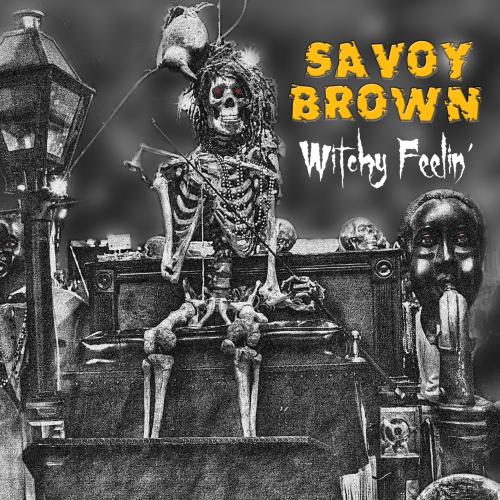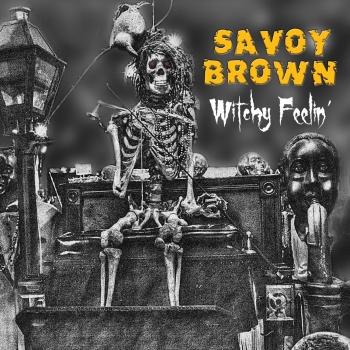
Witchy Feelin´ Savoy Brown
Album info
Album-Release:
2017
HRA-Release:
18.08.2017
Album including Album cover
I`m sorry!
Dear HIGHRESAUDIO Visitor,
due to territorial constraints and also different releases dates in each country you currently can`t purchase this album. We are updating our release dates twice a week. So, please feel free to check from time-to-time, if the album is available for your country.
We suggest, that you bookmark the album and use our Short List function.
Thank you for your understanding and patience.
Yours sincerely, HIGHRESAUDIO
- 1 Why Did You Hoodoo Me 05:13
- 2 Livin´On The Bayou 05:59
- 3 I Can´t Stop The Blues 05:25
- 4 Witchy Feelin´ 04:36
- 5 Guitar Slinger 03:51
- 6 Vintage Man 03:07
- 7 Standing In A Doorway 05:39
- 8 Memphis Blues 04:12
- 9 Can´t Find Paradise 04:28
- 10 Thunder, Lightning & Rain 07:54
- 11 Close to Midnight 04:08
Info for Witchy Feelin´
Blues ist nichts für schwache Nerven! Seit der Blues zum ersten Mal Luft geholt hat, haben seine größten Vertreter die Dunkelheit, Erzählungen von Not und Tod, bis hin zu höllischen Wesen und Teufeleien in die Musik eingeschlossen. Wenn das Cover von Witchy Feelin´ vermuten lässt, dass Kim Simmonds ebenfalls eine Tendenz zum Makabren besitzt, dann bestätigt dies der Frontmann von Savoy Brown gerne. „Blues handelt schon immer vom Teufel, Hexereien und dergleichen, zudem habe ich schon immer über diese Themen geschrieben! Mindestens drei Songs von Witchy Feelin´ haben Einflüsse der Hoodoo-Bewegung.“
Das 2017 bei Ruf Records veröffentlichte neue Album beweist, dass der Teufel wohl immer noch die besten Melodien hat! Vom aufregenden, zerbrechlichen Gitarrenriff, das der Song „Why did you Hoodoo me?“ eröffnet, sind wir mit Simmons in der Hand eines Meisters der den seismischen Gesang und das brachiale Saitenwerk, welches Savoy Brown als Dreh- und Angelpunkt des Blues-Booms der sechziger Jahre in Großbritannien etablierte. „ Auf diesem Album habe ich mein Bestes gegeben, um meine Stimme in ihrer vollen Kraft zu entfalten,“ erklärte Simmonds. „Ich habe eine Baritonstimme und höre gerne Sänger, mit denen ich mich vergleichen kann wie J.J. Cale, Mark Knopfler, Tony Joe White und Tom Rush. Für mein Gitarrenspiel werde ich immer noch inspiriert durch Buddy Guy, Otis Rush und all den Chicagoer Gitarristen , mit deren Musik ich in den Sechzigern aufgewachsen bin, aber ich höre auch immer neue Musik.
Zusammen mit dem Bassisten Pat DeSalvo, dem Schlagzeuger Garnet Grimm und dem Techniker Ben Elliots bringt uns Simmonds in eine Welt dunkler Ritter, wilder Stürme, Frauen und Whisky: alles immer aktuelle Themen, denen ein nicht altern wollender Bluesmann eine moderne Wendung gibt. „Die Songs von diesem Album sind zwei Jahre in der Produktion gewesen,“ reflektiert er, „ich habe versucht Songs zu schreiben, die eine persönliche Sichtweise haben und für jeden nachvollziehbar sind. Bei Vintage Man habe ich daüber geschrieben, wie es ist, ein Typ zu sein, der sich nicht verändert, wenn er älter wird. Why did you Hoodoo me? behandelt die Kraft der Liebe und in Guitar Slinger schreibe ich darüber, einen großartigen Gitarristen in einer alten Country Bar zu sehen – wie ich es 1969 erlebt habe, als ich Roy Buchanan zum ersten Mal sah.“
Jeder, der Zeuge von Savoy Browns Austritt aus den „The Blocks“ 1965 wurde, wird von einer identischen Epiphanie sprechen. Damals war es diese Band, die den Blues-Boom auslöste, die bei Decca unterschrieb und den Weg zum ersten Auftritt von Cream ebnete und einen Lead -Gitarristen aufweisen konnte, der im selben Atemzug mit Hendrix (mit dem er jammte) und Clapton genannt wurde. „Als ich die Band 1965 gründete, war das eigentliche Konzept, eine Art britische Version einer Chicagoer Blues Band zu werden!“, reflektiert Simmonds. „Und die Sache ist, dass diese Vision noch immer lebt!“
Nun hatten Savoy Brown das, was viele britische Bands nicht hatten: Erfolg in Amerika. Und sie erzielten einen gewaltigen Erfolg durch ihre unermüdliche Arbeitsethik und ihre energiereiche Musik. „Es wird zu viel über Sex, Drugs und Rock´n´Roll geredet,“ erzählte Simmonds Classic Rock. „Es ist ein Klischee, jedoch sind wir hart arbeitende Kerle! Als wir nach Amerika kamen, waren wir wie eine kleine Armee! Ich schaue zurück und sehe eine Zeit, die mit unglaublichen Talenten übersäht war.“ Diese Zeit veränderte sich natürlich und Simmonds entfernte sich von einem London, das er nicht mehr wieder erkannte, -„Die Punks waren überall!“- um sich in New York niederzulassen. Savoy Brown´s Bandmitglieder kamen und gingen und die Musikszene verlagerte sich um ihn herum, aber der Gitarrist blieb seinem Ideal treu und wurde dafür belohnt. Er trat an kultigen Orten, wie der Carnegie Hall und the Fillmore East and West auf, veröffentlichte ca. dreißig Alben und erhielt später einen wohlverdienten Platz in Hollywoods Rock Walk of Fame.
Auch im Post-Millennium, während seine Kollegen sich langsam weiterentwickelten und in eine Art Halbrente abdrifteten, behielt Simmonds seine Visionen und verschaffte sich dadurch einen Vorteil. Er spuckte erfolgreiche Alben wie 2011 Voodoo Moon, 2014 Going to the Delta, 2015 The Devil to pay und die empathische Neuheit in Savoy Brown´s Katalog: Witchy Feelin ´aus. „Ich bin überrascht, dass ich immer noch die Energie in mir habe, Gitarre zu spielen und Songs zu schreiben,“ berücksichtigt er, „Ich war in meinem Leben gesegnet und danke Gott dafür. Ich habe nie daran gedacht and der Vergangenheit festzuhalten - ich schaue nicht zurück und gratuliere mir selbst! Ich will immer den nächsten Berg erklimmen – und freue mich sehr über das neue Album.“
Kim Simmons, Gitarre, Gesang
Pat DeSalvo, Bass
Garnet Grimm, Schlagzeug
Savoy Brown
Legendary .... a blues/rock institution .... true innovators. These are just a few of the ways Savoy Brown has been described over the past 47 years by music critics and fans.
One of the earliest of British blues bands, with founder guitarist Kim Simmonds at the helm, Savoy Brown helped launch the 1967 UK blues boom movement that brought blues music back to the USA and invigorated the style from then on. In the process, the band became part of the framework that launched the rock and roll music of the 1970’s. Their influence now stretches into modern rock as we know it today.
The band recorded their first singles for Mike Vernon’s Purdah label in 1966 and quickly followed up with the landmark album “Shakedown”. Singer Chris Youlden joined the band in 1968 and many classic records appeared, with songs such as “I’m Tired” and “Louisiana Blues” becoming radio staples. Blues-rock and boogie music always was the band’s calling card and they captured, forever, the spirit of the music on the live side of “A Step Further” (1969) with a twenty-minute boogie “The Savoy Brown Boogie” dedicated to fans in Detroit.
By 1971, Youlden had departed on a solo career and band members Dave Peverett, Roger Earle, and Tony Stevens left to form their own group, Foghat.
Kim Simmonds rebuilt the band using former members of the blues band Chicken Shack and vocalist Dave Walker. That year, “Street Corner Talking” brought the band its best chart success up to that date. “Tell Mama”, “Street Corner Talking”, “All I Can Do Is Cry” and the band’s funky re-make of the Motown classic, “I Can’t Get Next To You”, took the band to platinum status and placed them in front of wildly enthusiastic rock audiences in arenas all over the world.
After the successful run of the early to mid 70's, Kim moved operations to the USA and continued making the kind of records he wanted to make with a succession of line-ups. Records as diverse as the acoustic blues “Slow Train" to the hard-hitting "Rock And Roll Warriors" appeared. All were eagerly accepted by the fans.
A three record deal with Crescendo in 1987 took the band into more of a rock direction, with records such as "Live 'n' Kicking" placing the group in a live setting, where they've always excelled.
In the '90's, "Let It Ride" was released. Kim enlisted Pete McMahon for vocal and harmonica duties in 1994 and added ex-Robert Cray drummer Dave Olsen to record "Bring It Home" for Viceroy. This set the tone for the next five years.
Nathaniel Peterson was brought in to handle bass playing and singing in the late 1990s. After touring the world extensively for three years, "The Blues Keep Me Holding On” was released in 1999 by Mystic Music. This modern blues record brought the band's epic music journey full circle.
With new goals in mind, Kim Simmonds took over vocal duties in 2001, leading to the 2003 release, "Strange Dreams", on Blind Pig Records. This was a hit with critics, and fans alike. Kim, as front man vocalist, fit the times perfectly. Changing into a three piece classic blues/rock outfit in 2006 and still doing double duty as guitarist and vocalist, Kim released the bands 30th album “Steel.”
In 2009, after nearly a decade of singing lead vocals, but wanting to concentrate again on his guitar playing, Simmonds brought in Joe Whiting as lead singer. The band thus became a four-piece aggregation with Garnet Grimm on drums and Pat DeSalvo playing bass. The new changes coincided with the release of a retrospective album “Too Much of a Good Thing” that covered the years 1992-2007.
The year 2011 brings the release of "Voodoo Moon" (November, Ruf Records) with this album showing good early sales, and reviews, to date.
The year 2012 sees Joe Whiting leaving the band late in the year.
The year 2013 likely brings a new album and the release of a live CD/DVD package recorded in Germany during May 2012.
So, from London’s Soho night clubs in 1966 to headlining the world’s most famous venues (Carnegie Hall, Fillmore’s East and West, Cobo Hall, etc.), you have Savoy Brown doing it all. The band continues to tour worldwide and they give a glimpse into the past, but also inspire new listeners with their personal brand of rocking boogie, blues and rock.
This album contains no booklet.







